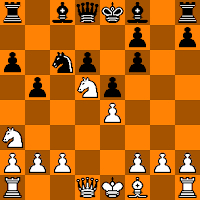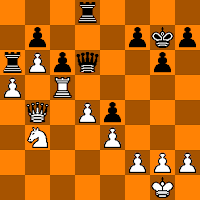IM NEVZAT SUER (1926-1987)
He
was born in 1926 in Istanbul. In 1946 he attained the 5th place at
Istanbul Chess Championship.
He
became the first Turkish IM together with Ilhan Onat in 1975 in
Italy.
Among
other tournaments abroad he represented the Turkish Republic in
Varna, Tel Aviv, Havana, Lugano, Skopje, Nice, Malta and Luzern
Olympics. He won the Turkish Chess Championship thrice in 68-69 and
1973. He wrote a chess column for the “Republican” newspaper for
17 years. This was the first chess column in Turkish history. He also
published the much cherished Suer Chess Magazine with his own means
till 1983.
The
Genius of Nevzat Suer
Now,
I strongly belive that Suer had an exceptional genius. To
demonstrate this I would like to narrate a story. One day N. Suer
suddenly came to my side and started telling me about a game he
played. According to the story he was playing in a local tournament
and his opponent played 1...f5 to everything except 1. e4. So what,
you may say but pls follow me till the end of the story. He said
that he played 1. e3 against his opponent and his opponent replied
with 1...f5 heartily.
1. e3 f5
You
may still be wondering what is so curious about this. Wait till you
see N. Suer's next move.
2. e4!!
2.
e4!! was the move Nevzat Suer played. Now Black is playing against
From Gambit (1.f4 e5) with colours reversed! The only other
alternative is to play 2...e5 and accept a King's Gambit with colours
reversed again. Since his opponent played and studied none of these
openings he had got into a squeeze. I was amazed and asked him what
his opponent did. He said that he played 2...e5 and lost in a few
moves because he did not know the basic plans pertaining to the
opening.
The
genius of Suer was to imagine this whole affair and virtualize it on
the board.
Music
Life of Nevzat Suer
We
learn much about Suer's musical life from his uncle. He was a very
sought after pianist in Turkey at that time and also played the
violin at the same virtuosity level.
Nevzat
Suer and Some Nice Stories
One
of the stories that I heard from FM A. Ipek was about when they went
abroad for a tournament.
They
were lodged at a hotel and the tournament began. Next day the team
got together at breakfast and N. Suer complained about the music
coming from outside at night. Some people agreed that the music was a
bit loud. Suer said “ No... No.. No... It is not the loudness of
the music that I am complaining about. It is the musician. He kept
playing the wrong note everytime at a certain point in the piece that
he was playing. He kept making the same mistake over and over again
and this kept me awake!”
He also arranged the participation of the Turkish contingency in the Havana Olympics and was awarded a chess analysis table by Fidel Castro.
What took place at
the Havana Olympics is shrouded in myths and legends. There are many
versions to the events taken place there. I was able to discern the
fact from the myth through Enis Bilyap who is the son of Siracettin
Bilyap who was one of the strong National Team players in the
Turkish contingency at the Havana Olympiad. He quotes his father
saying the following: “ An announcement was made that a
simultaneous display was to be made for the local residents. They
were looking for 50 volunteers willing to play in the simultaneous
exhibition from National Team players taking part in the Olympiad.
These volunteers were going to make a simultaneous exhibition for the
local residents and chess fans. It sounded a bit off but when the
oraganizers explained the logic entailed we were persuaded. In a
formation of 1000 people 50 Master players were going to place
themselves 20 players apart and move at the same intervals among the
players.
In the off day of
the Olympiad Nevzat and I went to the organization area for the
simultaneous. To describe the atmosphere there was impossible, one
must see it with their own eyes. There were players, tables, chess
sets and spectators in an area as large as 3-4 football fields. This
was a sight that I witnesses for the first time and I understood the
level of love for chess amongst the residents of Cuba. No nation
could be more passionate about chess than the Cubans. Of course
there is no need for me to mention the role Capablanca played in
this.
The simultaneous
started. We were with the most important players of the time and I
was enjoying myself immensely. Nevzat was playing 2 (tables) infront
of me. I think it was the 20th or the 21st move and suddenly a
tropical rain began. We tried to continue for a few seconds but then
all players began to search for a place to take cover. We too found
an appropriate place. The sun showed its face again after a rain that
took 30-40 mintes and everything went back to normal but the
simultaneous exhibition was called off.”
Suer
and Correspondence Chess
Suer
left a mark in all areas relating to chess and Correspondence Chess
was no exception.
He
played correspondence games and the only one I could find was the
one in the following link:
My
personal memories about N. Suer
N.
Suer always came to ISD (Istanbul Chess Association) to play chess
with his friends M. Boysan, D. Buyukozkaya and A. Ipek. They used to
play blitz. Sometimes Ilhan Onat used to come all the way from Izmir
and we witnessed a blitz showdown between the two IMs which everyone
watched.
One
day while talking, the subject came to his game with the Former World
Champion T. Petrossian. He had lost the game but he put the blame on
his tie. He said that his tie was too tight and prevented blood from
going to his brain and this gave rise to a loss. I smiled. I liked
his spirit!
He
lived as a bachelor and never got married. However I remember him
repeating the name of a lady called “Neval”. He used to say “Oh,
oh, Neval” now and then and very often. I personally think that it
was the name of his beloved. I hope they are finally together in the
afterworld.



























